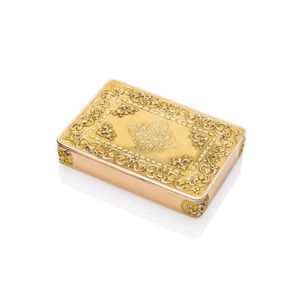Russian Tri-colour Gold Snuff Box by Keibel, 1830
You must be a subscriber, and be logged in to view price and dealer details.
Subscribe Now to view actual auction price for this item
When you subscribe, you have the option of setting the currency in which to display prices to $Au, $US, $NZ or Stg.
- Assay / Assayed - Assaying is the testing of a metal, most commonly silver and gold to determine its ingredients and quality. In Britain, once an item of silver or gold has been assayed, a mark is stamped on it, certifying its purity. Known as hallmark, it derives its name from the Guild Hall of the Goldsmiths' Company, who recieved its Charter in 1327 giving it the power to assay and mark articles of gold and silver.
- Circa - A Latin term meaning 'about', often used in the antique trade to give an approximate date for the piece, usually considered to be five years on either side of the circa year. Thus, circa 1900 means the piece was made about 1900, probably between 1895 and 1905. The expression is sometimes abbreviated to c.1900.
- Foliate - Decorated with leaves or leaf-like forms.
This item has been included into following indexes:
- snuff boxes, country of origin
- snuff boxes, material - gold 76
Visually similar items

An Edward VII sterling silver embossed rectangular jewel casket by William Comyns, London 1902, profusely decorated with swags, scrolls and classical masks, 28 x 14 cm, 8 cm high

A Persian silver box made in Isfahan, early twentieth century 18 x 9.5 cm

Stereoviews a group of 24 published by the Australasian Stereoscopic Co including convoy of Australians, Kit Inspections of Australians and Balloon Corp

Sterling silver 950 standard cigarette case etched with repeating leaf patterns to the exterior & with two internal compartments, each with elastic type crossed mechanical holders & having a button clasp. Stamped 'Sterling silver 950'. Condition: good, min
